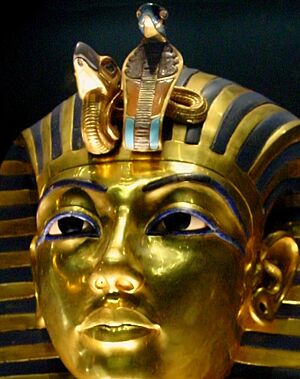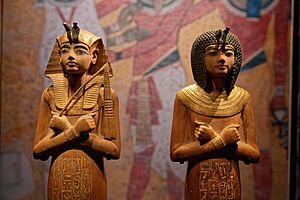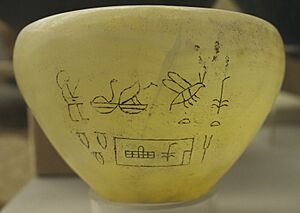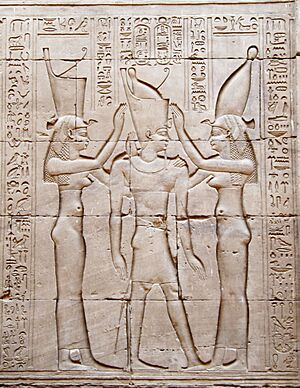Two Ladies facts for kids
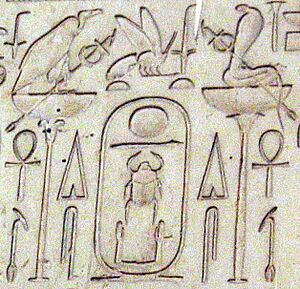
The "Two Ladies" (Ancient Egyptian: nbtj, also called Nebty) was a special name for two important goddesses in Ancient Egyptian beliefs. Their names were Wadjet and Nekhbet. They were like protectors for the ancient Egyptians. People worshipped them all over Egypt after the country became united.
Egypt used to be two separate parts: Lower Egypt and Upper Egypt. When they joined, these two goddesses stayed important. They became known as the 'Two Ladies' because they protected the whole united country.
After Egypt united, you could often see both goddesses together. Their images appeared on the uraeus, which was a symbol on the crowns of Egyptian rulers. The Two Ladies were believed to help create laws. They also protected the pharaohs and the land of Egypt, and they helped keep peace.
Contents
Why Were They Called the Two Ladies?
Special Names for Gods
Important gods and goddesses in the Egyptian pantheon (the group of all Egyptian gods) often had special names. These names were called epithets or titles. Using titles helped keep their true names secret from enemies. It also showed great respect for their powers.
Protecting the Pharaoh
The Two Ladies were seen as powerful protectors. For example, a pharaoh named Amenhotep III went on a military trip. Stone slabs (stelas) from his fifth year as ruler tell the story. These stelas were found near Aswan and Sai Island.
The story says that the Two Ladies appeared to Amenhotep III. They gave him advice and warned him about the leader of the Kush army. This showed how important they were in protecting the pharaoh.
The text says: "Regnal Year 5... the Two Ladies, Who [establish] laws and [pacify] the Two Lands... came to tell [the pharaoh], 'The fallen one of vile Kush has plotted rebellion in his heart.'"
This shows the Two Ladies giving a warning to the pharaoh. The story then describes how the pharaoh won the battle. It compares him to a fierce lion. This comparison is linked to Sekhmet, a powerful warrior goddess. She was often shown as a lioness. Pharaohs were sometimes called her sons, meaning they were also like lions in battle.
Sekhmet, Wadjet, and Nekhbet were very strong protectors of Ancient Egypt. They remained important even when other gods became more or less popular. Their images on the uraeus (the symbol on crowns) were kept even by pharaohs like Akhenaten. He tried to focus worship on only one god, Aten. But the Two Ladies still had a subtle presence. After his rule, the old religious traditions were fully restored.
The Nebty Name
|
|
The nebty name means "Two Ladies." It was one of the special titles given to an Egyptian pharaoh. This name honored the two patron goddesses of Upper and Lower Egypt:
- Nekhbet, the protector of Upper Egypt, was shown as a griffon vulture.
- Wadjet, the protector of Lower Egypt, was shown as an Egyptian cobra.
The nebty name was first used around 2920 BC by the First Dynasty pharaoh, Semerkhet. However, it became a fully independent title much later, by the Twelfth Dynasty, which started in 1991 BC.
This name usually did not have a cartouche (an oval frame) or a serekh (a rectangular frame). Instead, it always began with the hieroglyphs of a vulture and a cobra. Each animal rested on a basket. This basket symbol stood for the dual word "nebty." The rest of the title changed for each pharaoh. It would have been read as, "he/she of the Two Ladies," followed by the meaning of the rest of the title.
Later Representations
Ptolemaic Temple at Edfu
The Temple of Horus at Edfu was built during the Ptolemaic Dynasty. This was between 237 BC and 57 BC. It was built on top of an older temple.
On a carving (relief) at this temple, the two goddesses are shown crowning a Ptolemaic pharaoh. They are giving him the double crown, which combines their separate crowns. In this carving, the Two Ladies look fully like women. They do not have the animal parts (like a vulture head or cobra head) that were common in older Egyptian art. This is called an anthropomorphic representation.
The headdresses of the goddesses in this carving are also different from traditional ones. Both headdresses have a vulture at the bottom. But the vulture was only linked to Nekhbet. The cobra, which represented Wadjet, is missing from her headdress. This small detail shows that the foreign rulers, who were Greek, did not fully understand the old Egyptian traditions. They still wanted to be seen as continuing Egyptian culture.
Greek and Roman religious beliefs were less focused on animal forms than those of Ancient Egyptians. In traditional Egyptian art, these goddesses might have been shown as women with animal heads. Or they might have been shown only as the animals themselves.



